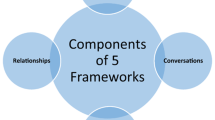Abstract
Using an ethnographic case study approach, we examined how teachers and parents within an ethnically diverse early childhood program conceptualized and implemented culturally relevant pedagogy and how these primary caregivers were encouraging children’s socio-cultural development and awareness. Data sources included questionnaires, interview transcripts, and observational field notes (classroom and community). Findings suggest there were multiple strategies and resources teachers used to facilitate the socio-cultural growth of young children indicative of culturally relevant practices. However, we discovered there were mediating factors that impacted how and whether teachers were able to implement culturally relevant pedagogy in the early childhood classroom.


Similar content being viewed by others
References
Banks, J. A. (1993a). Multicultural education: Historical development, dimensions, and practice. Review of Research in Education, 19, 3–49.
Banks, J. A. (1993b). Multicultural education for young children: Racial and ethnic attitudes and their modifications. In B. Spodek (Ed.), Handbook of research on the education of young children (pp. 236–250). New York: Macmillan.
Beauboeuf-Lafontant, T. (1999). The movement against and beyond boundaries. Politically relevant teaching among African American teachers. The Teachers College Record, 100(4), 702–723.
Carter, D. J. (2008). On spotlighting and ignoring racial group members in the classroom. In M. Pollock (Ed.), Everyday anti-racism: Getting real about race in school (pp. 230–234). New York: New Press.
Castro, A. J. (2010). Themes in research on preservice teacher’s views of cultural diversity: Implications for researching millennial preservice teachers. Educational Researcher, 39(3), 198–210.
Cochran-Smith, M. (2004). Walking the road: Race, diversity, and social justice in teacher education. New York: Teachers College Press.
Darling-Hammond, L., & Bransford, J. (2005). Preparing teachers for a changing world: What teachers should learn and be able to do. San Francisco, CA: Jossey-Bass.
Derman-Sparks, L., & Edwards, J. O. (2010). Anti-bias education for young children and ourselves. Washington, DC: National Association for the Education of Young Children.
Edwards, C., Gandini, L., & Forman, G. (Eds.). (2011). The hundred languages of children: The Reggio Emilia experience in transformation (3rd ed.). Westport, CT: Praeger ABC-CLIO.
Epstein, A. S. (2007). The intentional teacher: Choosing the best strategies for young children’s learning. Washington, DC: National Association for the Education of Young Children.
Espinosa, L. M. (2005). Curriculum and assessment considerations for young children from culturally, linguistically and economically diverse backgrounds. Psychology in Schools, 42(8), 837–853.
Gay, G. (2000). Culturally responsive teaching. New York: Teachers College Press.
Gay, G., & Kirkland, K. (2003). Developing cultural critical consciousness and self-reflection in preservice teacher education. Theory into Practice, 42(3), 181–187.
Gonzalez-Mena, J. (2009). Child, family and community: Family centered early care and education (5th ed.). Columbus: Pearson.
Groulx, J. G., & Silva, C. (2010). Evaluating the development of culturally relevant teaching. Multicultural Perspectives, 12(1), 3–9.
Gunn, A. A., Bennett, S. V., Evans, L. S., Peterson, B. J., & Welsh, J. L. (2013). Autobiographies in preservice teacher education: A snapshot tool for building a culturally responsive pedagogy. International Journal of Multicultural Education, 15(1), 1–20. Retrieved from http://ijme-journal.org/index.php/ijme/article/view/628/pdf.
Hilliard, A. G. (2006). Aliens in the education matrix: Recovering freedom. The New Educator, 2, 87–102.
Howard, T. (2003). Culturally relevant pedagogy: Ingredients for critical teacher reflection. Theory into Practice, 42(3), 195–202.
Ladson-Billings, G. (1994). The dreamkeepers. San Francisco, CA: Jossey-Bass.
Ladson-Billings, G. (1995). Toward a theory of culturally relevant pedagogy. American Educational Research Journal, 32(3), 465–491.
Ladson-Billings, G. (1999). Preparing teachers for diversity. In L. Darling-Hammond & G. Sykes (Eds.), Teaching as the learning profession (pp. 86–123). San Francisco, CA: Jossey-Bass.
Ladson-Billings, G. (2014). Culturally relevant pedagogy 2.0: a.k.a. the remix. Harvard Educational Review, 84(1), 74–84.
Love, A., & Kruger, A. C. (2005). Teacher beliefs and student achievement in urban schools serving black students. The Journal of Educational Research, 99(2), 87–98.
Miles, M. B., & Huberman, M. A. (1994). Qualitative data analysis. Thousand Oaks, CA: Sage.
National Center for Educational Statistics. (2013). The condition of education. Retrieved from http://nces.ed.gov/pubs2013/2013037.pdf.
Odom, S., Bryant, D., & Maxwell, K. (2012). Strengthening the early childhood care and education workforce would benefit young children. Social Policy Report Brief, 26(1). http://www.srcd.org/sites/default/files/documents/2012_1_sprbrief_rhodes.pdf.
Paris, D. (2012). Culturally sustaining pedagogy: A needed change in stance, terminology and practice. Educational Researcher, 41(3), 93–97.
Sleeter, C. (2008). Preparing White teachers for diverse students. In M. C. Smith, F. Nemieser, J. D. McIntyre, & K. E. Demers (Eds.), Handbook of research on teacher education: Enduring questions in changing context (3rd ed., pp. 559–582). New York: Routledge.
Souto-Manning, M. (2013). Multicultural teaching in the early childhood classroom: Approaches, strategies and tools for preschool-2nd grade. New York: Teachers College Press.
Ullucci, K., & Battey, D. (2011). Exposing color blindness/grounding color consciousness: Challenges for teacher education. Urban Education, 46(6), 1195–1225.
Wink, J., & Putney, L. (2002). A vision of Vygotsky. Boston, MA: Allyn and Bacon.
Author information
Authors and Affiliations
Corresponding author
Rights and permissions
About this article
Cite this article
Durden, T.R., Escalante, E. & Blitch, K. Start with Us! Culturally Relevant Pedagogy in the Preschool Classroom. Early Childhood Educ J 43, 223–232 (2015). https://doi.org/10.1007/s10643-014-0651-8
Published:
Issue Date:
DOI: https://doi.org/10.1007/s10643-014-0651-8




